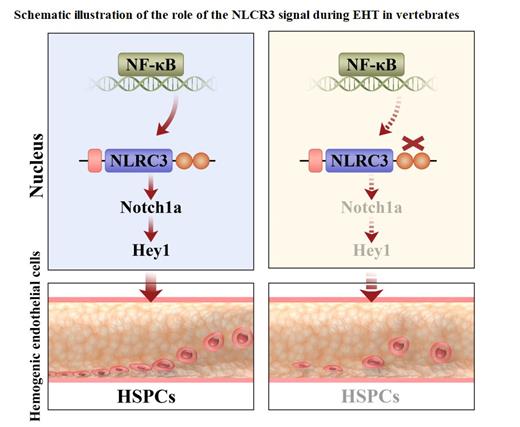Hematopoietic stem and progenitor cells (HSPCs) generate all the lineages of blood cells throughout the lifespan of vertebrates. The emergence of HSPCs occurs through the hemogenic endothelial (HE) to hematopoietic transition (EHT) process, which is finely tuned by a variety of signaling pathways. Previous studies have emerged the essential roles of pattern-recognition receptors such as Toll-like receptors and RIG-I-like receptors in EHT. However, whether the nucleotide-binding domain leucine-rich repeat (NLR) containing family members participate in vertebrate embryonic hematopoiesis remains unclear.
To explore the potential pathways involved in hematopoietic ontogeny and differentiation in this stage, we screened the dynamic expression of NLR family genes and other genes related to inflammation in the published scRNA-seq data in vertebrates' embryos including zebrafish, mouse and human during HSPC development. And to verify the expression of NLR family genes in vitro by using HSC-like cells differentiation system of mouse and human embryonic stem cells (ESCs), these results suggest that NLRC3 was highly expressed during embryonic HSPC development in vivo and vitro and might play an important role in HSPC emergence in vertebrates.
In order to validate this hypothesis, we synthesized probes from the full-length mRNA of nlrc3 and utilized them to observe the in-situ expression of nlrc3 in zebrafish at different developmental stages. The WISH experiment demonstrated that nlrc3 was expressed from the 1-cell stage and importantly, showed specific expression in the AGM region at the 24-28hpf and CHT region at 72hpf, which coincides with the onset and generation of HSPC generation. Then morpholino were utilized to knockdown nlrc3 in transgenic embryos Tg( runx1:EGFP/ kdrl:mCherry), Tg( cmyb:EGFP/ kdrl:mCherry) and Tg( CD41:GFP), and mutants generated by CRISPR-Cas9 were used to perform whole-mount in situ hybridization (WISH) and qPCR to detect specific markers such as runx1, cmyb(HSPCs), rag1(lymphocytes), gata1a(erythrocytes) and l-plastin(myelocytes), etc. The results showed that nlrc3 was required for HSPCs emergence, expansion and differentiation. In primitive hematopoietic wave, nlrc3 signaling may not impact primitive erythropoiesis but required for primitive neutrophils and macrophages.
Mechanistically, we sorted EGFP + cells in Tg ( fli1a:EGFP) zebrafish embryos at 28 hpf to perform RNA-Seq, which was the stage where EHT and these EGFP + cells contained hemogenic endothelial cells. After bioinformatics analysis of sequencing data, we found that the effect of nlrc3 in zebrafish hematopoiesis is not based on affecting the development of arterial vessels or causing apoptosis. By using targeted inhibitor such as DAPT and JSH23, conditional rescue model like Tg ( hsp70:GAL4/ UAS:NICD), overexpression expression experiment in Tg ( tp1:EGFP/ kdrl:mCherry) and nlrc3 -/- mutants, etc, through Imaging systems and qPCR we found that NF-kB- nlrc3-Notch- hey1 axis triggers HSPCs emergence and differentiation in zebrafish.
To further extend our findings in mammals, we utilized Nlrc3 knockout mice to explore whether Nlrc3 signaling was evolutionarily conserved in HSPCs emergence. Hematogenic endothelial cells (CD31 + CD41 - CD45 - TER119 -) from the embryonic AGM tissues at E10.5 were sorted and cultured in OP9 for 4 days and flow cytometry was performed to assess that c-Kit +CD45 + hematopoietic cells and CD31 +Sca-1 +CD201 + hematopoietic stem cells were notably decreased in these Nlrc3-/- embryos. Colony-forming unit-cell (CFU-C) assay and BM transplantation experiments were used to observe that fetal liver HSCs from E14.5 Nlrc3-/- embryos was decrease in the number and impaired in function in vitro and in vivo. Finally qPCR using mRNA from FL-derived LSK ( Lin-c-Kit+Sca-1+) cells further demonstrated that the NF-kB- Nlrc3-Notch- Hey1 axis orchestrated development of embryonic HSCs was highly conserved in vertebrates.
Overall, by summarizing the results of the physiological and developmental roles in vivo and in vitro, we uncover an indispensable role of Nlrc3 signaling in vertebrates' HSPCs emergence, our findings provide new insights into inflammation-related hematopoietic ontogeny and Nlrc3 signal is of major importance since this investigation might be taken into consideration when recapitulation definitive hematopoiesis in vitro.
Disclosures
No relevant conflicts of interest to declare.


